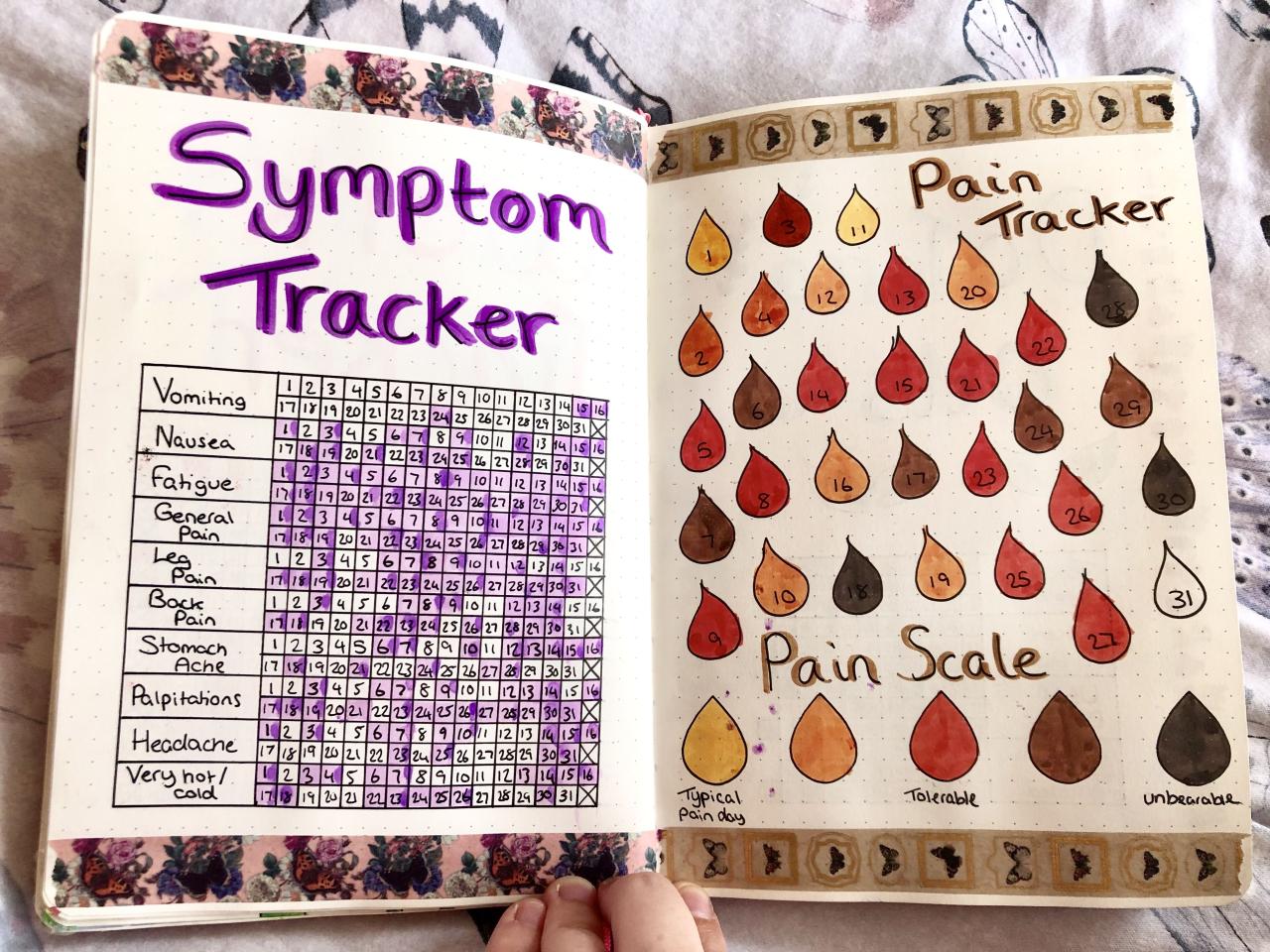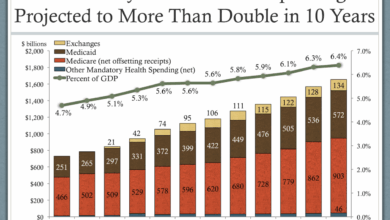
Bujoy these bullet journal spreads for pain management are game changers. They’re not just pretty pages; they’re powerful tools for taking control of your pain. Imagine a system where you meticulously track your pain levels, triggers, and even medication, all within the aesthetically pleasing structure of your bullet journal. This detailed guide explores how bullet journaling can become your personalized pain management companion.
This post dives deep into the specifics, from creating daily pain logs and weekly reviews to visually representing patterns over time. We’ll also discuss integrating these spreads with other self-care practices and customizing them for various pain conditions. Get ready to unlock a new level of pain management awareness and empowerment through the art of bullet journaling.
Introduction to Bullet Journal Spreads for Pain Management

Bullet journaling, a customizable system for planning and organization, has found a unique niche in self-care practices. Its flexibility allows individuals to tailor it to address specific needs and concerns, and pain management is no exception. This adaptable approach provides a structured way to track pain levels, triggers, and coping mechanisms, ultimately fostering a deeper understanding of personal pain patterns and promoting proactive pain management strategies.By meticulously recording pain experiences, individuals gain valuable insights into potential triggers, patterns, and the effectiveness of various coping mechanisms.
This awareness empowers them to take control of their pain journey, leading to more effective self-management. Bullet journaling can be a powerful tool for pain management, providing a sense of order and control amidst often unpredictable discomfort.
Potential Benefits of Bullet Journaling for Pain Management
Bullet journaling offers a plethora of benefits in pain management, going beyond simple record-keeping. It allows for detailed documentation of pain, enabling individuals to identify patterns, triggers, and the effectiveness of different strategies. This understanding leads to personalized pain management plans, potentially minimizing pain episodes and improving overall well-being. Tracking pain patterns over time can help uncover hidden connections between activities, environments, or emotional states and pain intensity.
This knowledge empowers individuals to make proactive adjustments in their lifestyle and environment to potentially reduce pain episodes.
Examples of Bullet Journal Spreads for Different Types of Pain
Different types of pain necessitate varying journaling approaches. For chronic back pain, a spread might include daily pain ratings, alongside notes on activities, posture, and any medications taken. This allows for the identification of potential correlations between these factors and pain intensity. For migraines, a dedicated spread could track triggers like stress levels, sleep patterns, food intake, and environmental factors.
This tailored approach helps pinpoint patterns and enables proactive measures to prevent or mitigate migraine episodes. A spread for menstrual cramps could include daily pain levels, dietary intake, stress levels, and any remedies tried.
Comparing Bullet Journal Methods for Pain Tracking
| Method | Description | Strengths | Weaknesses |
|---|---|---|---|
| Daily Pain Logs | Detailed records of pain levels, triggers, and coping mechanisms for each day. | Provides a comprehensive daily record, allowing for quick identification of patterns. | Can be time-consuming, especially if detailed information is recorded for each aspect. |
| Weekly Calendars | Overviews of pain levels and patterns over a week. | Provides a visual representation of pain trends and fluctuations. | May not capture the nuances of daily pain experiences. |
| Monthly Summaries | A high-level overview of pain experiences and coping strategies throughout a month. | Offers a broad perspective on pain patterns over a longer period. | Might not capture short-term or sudden changes in pain intensity. |
This table highlights the different bullet journal methods for pain tracking. Each method provides unique insights, and the optimal choice depends on the individual’s specific needs and preferences. Daily logs offer a precise view of daily experiences, while weekly calendars give a broader picture of pain trends. Monthly summaries offer a long-term perspective. Individuals can choose the method that best suits their individual needs.
Specific Spread Types for Pain Management
Bullet journal spreads for pain management can significantly enhance your ability to track, understand, and manage your pain effectively. These structured layouts empower you to document experiences in a clear and organized way, leading to better communication with healthcare providers and improved self-awareness. This allows for proactive adjustments to your pain management strategy.These spreads provide a personalized record of your pain journey, aiding in identifying patterns and triggers.
I’ve been absolutely loving these bullet journal spreads for managing my pain – they’re truly game-changing. It’s fascinating how much our daily lives can be affected by chronic pain, but navigating the complexities of pain management is also often made more challenging by societal discussions. For instance, the debate surrounding whether pregnant women who drink alcohol should face legal repercussions is a contentious one, and articles like this one exploring the topic are worth considering when trying to understand the broader societal perspectives on health choices during pregnancy should pregnant women be jailed for drinking.
Regardless, these bullet journal spreads are helping me stay organized and on top of things, which is essential for my well-being.
This detailed insight helps you work collaboratively with your doctor to refine your pain management plan, leading to a more holistic approach.
Daily Pain Log Spread
A daily pain log is crucial for capturing the nuances of your pain experience. This record provides invaluable insights into the fluctuations of your pain throughout the day.
- Time of Pain Onset: Record the precise time when your pain began. This data is essential for recognizing potential patterns, such as pain related to specific activities or times of day. A precise time helps identify correlations between your pain and your lifestyle.
- Pain Location: Detail the exact location of the pain using clear and descriptive language. This allows for precise documentation and helps your healthcare provider pinpoint the area requiring attention. For example, instead of “back pain,” note “lower back pain, radiating to the left hip.”
- Pain Intensity: Utilize a pain scale (e.g., 0-10 scale) to quantify the intensity of your pain. This allows for objective measurements that help track progress and identify fluctuations.
- Pain Description: Provide a detailed description of the pain, including its character (e.g., sharp, dull, throbbing). Note any accompanying symptoms like numbness, tingling, or stiffness. This will help you understand the pain more comprehensively.
- Pain Triggers: Document potential triggers for your pain. This could include activities, food, stress levels, or environmental factors. Note any correlations between triggers and pain intensity.
- Medication Usage: Record the type, dosage, and time of any pain medication taken. This data is crucial for tracking effectiveness and potential side effects. This also helps with communication with your doctor about the medications you are taking.
Organizing Pain Triggers and Intensity Levels
Categorizing pain triggers and intensity levels within your spread aids in identifying patterns and correlations. This systematic approach enhances your understanding of pain factors and allows you to proactively adjust your lifestyle.
- Pain Triggers: Use a dedicated section or column to list potential triggers. Categorize them (e.g., physical activity, stress, diet). This organized approach helps in identifying recurring patterns, which can be crucial in developing strategies to manage triggers effectively.
- Intensity Levels: Implement a visual pain scale (e.g., a 0-10 scale with corresponding emojis or color-coding). This helps in tracking pain intensity over time, allowing you to visualize trends and communicate them effectively to healthcare professionals.
Documenting Pain Medication Usage
A dedicated section for documenting medication usage is vital for tracking effectiveness and identifying potential side effects. This methodical approach helps ensure that you are taking the necessary steps to manage your pain effectively.
- Medication Type: Clearly list the name of each medication taken.
- Dosage: Record the dosage and frequency of each medication.
- Time Taken: Note the precise time when each medication was taken.
- Effectiveness: Assess the effectiveness of each medication, noting how it impacted the pain intensity and duration. Use a scale to quantify the impact.
Weekly Pain Review Spread
A weekly pain review spread provides a summary of your pain experiences over the week. This overview helps in recognizing patterns and making adjustments to your pain management plan.
| Day | Pain Location | Pain Intensity (0-10) | Pain Description | Triggers | Medication |
|---|---|---|---|---|---|
| Monday | Lower back | 7 | Aching, sharp | Lifting heavy boxes | Ibuprofen 200mg, 2x/day |
| Tuesday | … | … | … | … | … |
Monthly Pain Summary Spread
A monthly summary provides a broader perspective on your pain experiences over a month. This long-term view helps in identifying trends and discussing them with your doctor.
- Summary of Pain: Summarize the overall pain experience for the month. Note any significant changes or patterns.
- Average Pain Intensity: Calculate the average pain intensity for the month.
- Medication Effectiveness: Evaluate the effectiveness of medications used over the month.
- Triggers: Summarize the most common pain triggers experienced.
Visual Representation of Pain Patterns
Visually representing pain patterns enhances your understanding of pain trends. This can be achieved through graphs, charts, or color-coding.
- Line Graphs: Illustrate pain intensity fluctuations over time using line graphs.
- Color-Coding: Assign different colors to various pain intensities or locations. For example, red for high intensity, blue for low intensity.
- Symbols: Use symbols to represent specific pain triggers or types of pain (e.g., a red circle for headaches, a blue star for muscle pain).
Integration with Other Self-Care Practices
Bullet journaling for pain management isn’t a standalone solution; its true power lies in its integration with a holistic self-care approach. By combining it with mindfulness, relaxation techniques, and other strategies, you can create a comprehensive system for managing pain effectively and improving your overall well-being. This integrated approach emphasizes the interconnectedness of physical, mental, and emotional health.Effective pain management requires a multifaceted strategy that addresses the root causes and symptoms.
This means understanding that pain isn’t just a physical sensation but can also be influenced by stress, anxiety, and sleep patterns. Bullet journaling allows you to track these interconnected factors, helping you identify patterns and develop strategies to address them.
I’ve been blown away by how much these bullet journal spreads for pain management have helped me. It’s like having a personalized toolkit for managing my discomfort. Recently, I also learned about a fascinating story of a baseball legend finding renewed purpose after the tragic passing of a pro football player. It really made me think about how unexpected acts of kindness and resilience can emerge in the face of loss.
It’s a reminder that, like those bullet journal spreads, even the smallest things can make a huge difference in managing challenges and finding strength, which is something that I think we can all relate to. These bullet journal spreads are truly game changers for pain management, like that baseball legend’s unexpected new life after the tragic death of a fellow pro football player.
baseball legend gets new life after death of pro football player.
Mindfulness and Relaxation Techniques
Mindfulness practices, like meditation and deep breathing exercises, are crucial adjuncts to pain management. Bullet journaling can track the effectiveness of these techniques in relation to pain levels. For instance, a spread could include a dedicated space for noting the type of mindfulness exercise, duration, and the subsequent impact on pain intensity. This allows you to identify activities that provide the most relief.
Incorporating relaxation techniques, like progressive muscle relaxation or guided imagery, into your journal can further enhance your self-care routine.
Integration with Physical Therapy
Physical therapy is often a cornerstone of pain management. By using your bullet journal, you can effectively document exercises, stretches, and their impact on pain. A spread dedicated to physical therapy sessions can record exercises performed, pain levels before and after, and any adjustments needed. This detailed documentation allows for effective communication with your physical therapist, enabling them to tailor your treatment plan based on your personal progress and experiences.
It also helps you stay motivated and accountable to your physical therapy goals.
Comparison with Other Pain Management Tools
Traditional pain management tools, such as medication logs or symptom trackers, often focus solely on the physical aspects. Bullet journaling, however, allows for a more comprehensive approach by incorporating emotional and mental factors. This holistic perspective enables a deeper understanding of the triggers and responses associated with pain, leading to more effective strategies. While other tools might focus on medication dosages or symptom severity, a bullet journal can track the impact of emotional stressors, sleep patterns, and other factors that influence pain.
Potential Benefits of Combining Bullet Journaling with Medical Treatments
Combining bullet journaling with physical therapy or other medical treatments can yield significant benefits. This integration allows you to monitor how your treatments interact with other aspects of your life, leading to a more personalized and effective pain management plan. For instance, you might notice that a particular medication correlates with increased stress levels, allowing you to adjust your coping mechanisms.
Or, you could observe that a specific exercise routine improves both physical and emotional well-being, leading to a positive feedback loop.
Step-by-Step Guide for Setting Up a Comprehensive Pain Management Journal
| Step | Action | Description |
|---|---|---|
| 1 | Define Goals | Clearly Artikel your pain management objectives. What do you hope to achieve? |
| 2 | Choose a Spread Type | Select the appropriate spread layouts for tracking pain levels, medication, therapies, and self-care activities. |
| 3 | Track Symptoms | Create dedicated spaces to record pain intensity, location, duration, and any associated symptoms. |
| 4 | Document Self-Care | Include sections for mindfulness exercises, relaxation techniques, sleep patterns, and stress levels. |
| 5 | Integrate Medical Treatments | Record details of physical therapy sessions, medication, and other medical interventions. |
| 6 | Review and Reflect | Regularly review your journal entries to identify patterns, triggers, and effective coping strategies. |
Visual Representation and Organization
Bringing a visual element to your pain tracking in a bullet journal is a game-changer. Visual representations transform raw data into easily digestible insights, allowing you to identify patterns and trends in your pain experience more effectively. This visual approach not only aids in tracking but also empowers you to understand your body’s responses better, ultimately leading to more informed decisions about your pain management strategy.Visual representation helps to make the pain tracking process more engaging and motivating.
By using colors, symbols, and charts, you create a personalized and aesthetically pleasing journal that becomes a valuable tool for understanding and managing your pain. This active engagement is often more effective than simply recording data in a plain list.
Visualizing Pain Patterns
Visualizing pain patterns is crucial for understanding how your pain behaves. Charts and graphs provide a clear picture of your pain levels over time, allowing you to identify trends, triggers, and potential correlations between your pain and other factors. These visualizations can be used to identify patterns in your pain experience, helping you understand your body’s responses and develop effective strategies for pain management.
Charts and Graphs for Pain Tracking
Using charts and graphs to track pain is a powerful method for visualizing patterns. A simple line graph can illustrate fluctuations in pain intensity over a period. The x-axis can represent dates or time intervals, while the y-axis represents pain levels (e.g., 1-10 scale). This creates a visual representation of pain trends. Bar graphs can also be used to compare pain levels across different activities or situations.
For example, you could track your pain levels before, during, and after exercise. Using different colors for each activity helps you easily compare data. Furthermore, a scatter plot can reveal correlations between pain and other factors, such as stress levels, sleep quality, or dietary choices.
Color-Coding and Symbolism
Employing colors and symbols in your pain tracking is a highly effective strategy. Different colors can represent different types of pain, such as sharp, dull, or throbbing pain. Using various colors and shapes (e.g., circles, squares, triangles) allows you to visually categorize and differentiate different pain experiences. Symbols can represent specific pain triggers, such as stress, caffeine consumption, or specific physical activities.
Consistent use of colors and symbols ensures that the visual representation is easily understandable and meaningful to you.
Representing Pain Trends Over Time
Representing pain trends over time is essential for effective pain management. A timeline with colored markers indicating pain levels can illustrate fluctuations in pain severity over a period. You can visually track the duration and intensity of pain episodes, allowing you to recognize patterns and potential triggers. Using different colors for different pain levels (e.g., green for low pain, yellow for moderate pain, red for high pain) provides a clear visual representation of trends.
This allows you to spot patterns and triggers, potentially leading to a better understanding of your pain experience and enabling you to adjust your pain management strategies accordingly.
Using Images and Stickers
Images and stickers can be powerful additions to your pain management spreads. For example, a sticker of a relaxing scene could represent a day when you successfully managed your pain with mindfulness practices. Similarly, a sticker of a challenging activity could represent a day when you pushed yourself and experienced higher pain levels. This visual representation makes the journal more personal and helps to reinforce positive coping strategies.
These visual cues can make the journal more engaging and motivating.
Aesthetically Pleasing Spreads for Motivation, Bujoy these bullet journal spreads for pain management are game changers
Creating aesthetically pleasing spreads can significantly boost your motivation. Use high-quality pens, washi tape, and decorative elements to make your pain tracking pages visually appealing. The goal is to create a journal that feels encouraging and supportive, not just functional. A visually appealing journal can be a source of motivation and engagement, helping you maintain consistency in your pain tracking and self-care practices.
A pleasant aesthetic can reinforce your motivation to continue with your pain management efforts.
Accessibility and Customization
Bullet journal spreads for pain management are most effective when tailored to individual needs. This involves understanding the specific pain conditions and triggers, and personalizing the visual representation to ensure ease of use and engagement. Adaptability and flexibility are key for long-term use and sustained benefit.Personalizing bullet journal spreads for pain management is crucial for effective self-care. Different pain conditions require unique approaches, and tailoring the visual representation to individual experiences enhances the usefulness of the tool.
Customizing for Different Pain Conditions
Tailoring spreads to specific pain conditions necessitates recognizing the unique characteristics of each. For instance, chronic back pain might benefit from a spread focusing on daily activity levels and pain intensity tracking, while migraines could use a spread identifying potential triggers and correlating them with symptom severity.
Examples of Trigger-Specific Spreads
A migraine spread might include a section for food logs, noting which foods seem to trigger headaches. A daily sleep log could be integrated into a chronic pain spread to correlate sleep quality with pain levels. A spread for fibromyalgia might include a comprehensive pain log, tracking the location and intensity of pain throughout the day. Each spread should be uniquely structured based on the particular pain condition.
I’ve been absolutely loving these bullet journal spreads for pain management – they’re truly game-changers! Tracking my pain levels, medication schedules, and relaxation techniques has been so helpful. Speaking of relaxation, checking out how pools, hot tubs, and beach activities can impact diabetes management is also interesting. pools hot tubs beach diabetes offers some great insights.
Ultimately, these bullet journal strategies are invaluable for managing my overall well-being.
Accessibility Considerations
Accessibility features are essential for individuals with various needs. Large print spreads, simplified layouts, and the use of color coding for different pain levels can enhance comprehension and usability. The use of symbols and icons can further increase the clarity and accessibility for those with visual impairments or cognitive differences. Spread layouts should be adaptable to assistive technology, such as screen readers.
Personalizing Visual Aesthetics
Visual customization enhances engagement and aids in better understanding of patterns. Personalizing the visual aesthetic enhances motivation and aids in recognizing patterns. The following table offers examples of different personalization methods.
| Personalization Method | Description | Example |
|---|---|---|
| Color Coding | Using different colors to represent different pain levels, activities, or triggers. | Green for low pain, yellow for moderate, red for high. |
| Symbols and Icons | Using symbols or icons to represent specific activities, triggers, or emotions. | A small plus symbol to indicate an activity that exacerbated pain. |
| Font Selection | Using large or easy-to-read fonts. | Choosing a bold, sans-serif font. |
| Layout Design | Organizing the spread in a clear and logical manner. | Using columns for different pain locations, or rows for tracking daily pain levels. |
| Visual Themes | Choosing a visual theme that resonates with the individual. | A calming color scheme for chronic pain. |
Flexibility and Adaptability
Bullet journal spreads should be adaptable to changing needs. Flexibility allows the spreads to be adjusted as pain levels or triggers evolve. As pain conditions and responses change, the spreads should be easily modified to accommodate these shifts. Spreads should be designed to evolve with the user’s experience.
Examples of Specific Spreads: Bujoy These Bullet Journal Spreads For Pain Management Are Game Changers

Bullet journal spreads offer a powerful visual and organizational tool for managing pain. These spreads aren’t just for recording symptoms; they’re a personalized roadmap to understanding your pain patterns and developing coping strategies. By tracking triggers, responses, and interventions, you gain valuable insights into your body’s unique reactions. This allows for proactive adjustments to your self-care routine.This section dives into practical examples of specific spreads designed for various types of pain, demonstrating how to use a bullet journal to monitor symptoms, track treatments, and cultivate a deeper understanding of your personal pain management journey.
Headache Management Spread
This spread focuses on documenting headache occurrences, noting potential triggers and associated symptoms. A weekly or monthly layout is effective. A table format is recommended for easy visualization. Each row represents a headache episode, with columns for the date, time, duration, intensity (using a scale, e.g., 1-10), location, symptoms (e.g., throbbing, pressure, nausea), triggers (e.g., stress, caffeine withdrawal, lack of sleep), and coping mechanisms (e.g., rest, medication, relaxation techniques).
This detailed record allows for identifying patterns and potentially avoiding triggers in the future.
Menstrual Cramp Tracking Spread
A cyclical spread is ideal for tracking menstrual cramps. Use a calendar-like layout, perhaps a monthly spread or even a yearly spread if you’d like to track trends over time. Include columns for the date, the day of the cycle, the intensity of cramps (using a scale), associated symptoms (e.g., bloating, mood changes, fatigue), coping strategies employed (e.g., heat pads, medication, yoga), and any other relevant notes.
By charting this data, you can discover correlations between your cycle, symptoms, and coping mechanisms.
Chronic Back Pain Management Spread
This spread should focus on daily activities and their impact on back pain. A daily log is helpful for tracking the intensity of pain, noting the specific activities performed, and the time spent engaging in each activity. Consider using a scale to rate pain intensity. This allows you to identify activities that exacerbate pain and those that provide relief.
This spread also has space to record any interventions, such as physiotherapy sessions, medication adjustments, or changes in posture.
Arthritis Pain Management Spread
A daily log is ideal for tracking arthritis pain. Include columns for the date, time, body part affected, pain intensity (on a scale), activities performed, and any medications or therapies used. It’s helpful to note the time of day when pain is most severe. This allows you to identify correlations between activities, medication effectiveness, and pain levels.
Fibromyalgia Symptom Management Spread
A weekly or monthly spread is recommended for tracking fibromyalgia symptoms. A comprehensive spread will include columns for the date, time, specific symptoms experienced (e.g., fatigue, muscle pain, sleep disturbances, cognitive difficulties), pain intensity, coping mechanisms used, and any other relevant notes. A dedicated space for tracking sleep quality, mood, and stress levels can significantly enhance this spread’s effectiveness.
By tracking these symptoms together, you gain a clearer picture of how different factors interact and influence your overall well-being.
Conclusion
In conclusion, these bullet journal spreads aren’t just about pretty designs; they’re about taking proactive steps towards managing your pain. By meticulously documenting your pain, triggers, and responses, you gain valuable insights into your body and develop a more personalized approach to pain relief. Remember that consistency is key, and tailoring your spreads to your unique needs and preferences is crucial for long-term success.
Start today, and witness the transformative power of a well-organized bullet journal.





